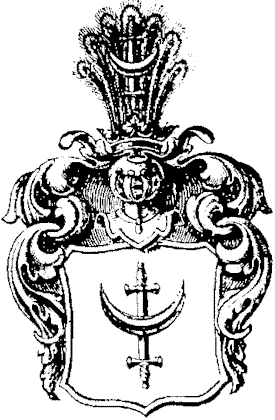Herb Trzaska
Research Heraldry Herb Trzaska
Herbarz Polski translation
Trzaska herb
 The following was prepared from an entry in the classic heraldic reference Herbarz Polski (by Kasper Niesiecki, S. J., Lipsk [Leipzig] edition, 1839-1846) by Leonard.J. Suligowski, 218A North Henry, Brooklyn, NY 11222-3608. The blazon or verbal description of the arms below is first given in the authentic heraldic style, followed by a translation from the Polish description by Niesiecki. The right and left sides of a shield are identified from the standpoint of the bearer, i. e., the one holding the shield. His right would be your left and vice versa. The tinctures (colors) in heraldry are as follows: azure = blue; gules = red; sable = black; or = gold; argent = silver; vert = green. In heraldry all charges (pictures) on a shield are already assumed to be facing dexter (right side) unless otherwise specified. In Polish heraldry all animals or birds are assumed to be in their natural coloring unless otherwise specified.
The following was prepared from an entry in the classic heraldic reference Herbarz Polski (by Kasper Niesiecki, S. J., Lipsk [Leipzig] edition, 1839-1846) by Leonard.J. Suligowski, 218A North Henry, Brooklyn, NY 11222-3608. The blazon or verbal description of the arms below is first given in the authentic heraldic style, followed by a translation from the Polish description by Niesiecki. The right and left sides of a shield are identified from the standpoint of the bearer, i. e., the one holding the shield. His right would be your left and vice versa. The tinctures (colors) in heraldry are as follows: azure = blue; gules = red; sable = black; or = gold; argent = silver; vert = green. In heraldry all charges (pictures) on a shield are already assumed to be facing dexter (right side) unless otherwise specified. In Polish heraldry all animals or birds are assumed to be in their natural coloring unless otherwise specified.
Arms: Azure, two swords Argent in pale hilted and pommeled Or, conjoined at the blade's mid point and debruised of a crescent at a fess point, also Or. For a crest, a panache of peacock plumes, all proper, charged with the arms of the shield. There is a new moon, as it were, not full, with both ends upward, yellow in a blue field, and two chipped sword pommels with crosses and hilts, of which one is in the middle of the moon, and the other beneath it. On a helmet above a crown is a peacock's tail, with the same moon and pommels. That is how Paprocki described it in his Gniazdo cnoty [Nest of Virtue], pages 45 and 1187, and in O herbach [Of Clan Shields], page 265; also Okolski in vol.3, page 240, and in Klejnoty [Crests], page 87. This clan shield is known by the names Trzaska, Biala and Lubiewa.
This shield was bestowed upon a knight named Trzaska [Translator--a word meaning "chip, splinter"] by King Boleslaw the Brave [992-1025] on an occasion when an enemy rushed towards the King with drawn sword. The abovementioned knight blocked the way and shielded his lord, but could not withstand the enemy force for long. For when he struck at the enemy's neck with all his might, his sword shattered almost at the hilt. The King, seeing this, quickly gave Trzaska his own sword. With it the knight, who was strong by nature, not only hacked that enemy to death, but slashed others as well, so that a circle thick with bodies surrounded him. Finally this sword, too, broke off, and after the battle had been won he gave it back to Boleslaw. As a reward for his courage and beautiful heart, the King gave him the shield in this form. Paprocki adds that he was later called Lubiewa, because the knight endowed the Lubin monastery in Great Poland, where three members of this house, one after another, ruled as abbots, and in memory of this endowment by them, to this day that monastery uses the Trzaska shield in its seal.
In reading monastery charters Paprocki found these ancestors in ancient times from this house: Count Morcha of Biala in 1091; Count Mstygen of Biala in 1180; and Klemens Szeliga of Janowice, chamberlain of Sieradz in 1436 - but Paprocki also placed him under the Szeliga clan shield.
Some families with the name of this shield flourish to this day in the district of Łomża, such as Stanislaw Trzaska, who in 1582 at Pskov dismounted from his horse and walked on foot towards the battle (Paprocki, O herbach, page 405): Pawel Trzaska in 1680; and Jadwiga Trzaska, a Benedictine nun at All Saints in Lwow. At the Horodlo sejm and the Union of Lithuania and Poland it was Mojdylon or Mejdalon Kufolowicz who took this clan shield for himself and his progeny (according to Bielski, page 314), or Czusolowicz (according to Stryjkowski, page 542). There were Adam and Samuel in Warsaw district, and Walentyn, Pawel, Maxymilian and Kazimierz in Nur district in 1697. In 1778 Felix Traszka was the Łomża standardbearer. In 1788 Thomas was the Opoczno border marshal, per Krasicki.
Families Bearing This Shield
Bialy, Bielski, Blazejowski, Budkiewicz, Chojnacki, Chrzaszczewski, Chrzczonowski, Dluski, Glinka, Goluchowski, Golynski, Kleczkowski, Kotowski, Kurnochowski, Lubiewski, Michalowski, Nartowski, Niemirowski, Pancerzynski, Paplinski, Patkowski, Pielesz, Podbielski, Podsedkowski, Ponikiewski, Poplawski, Popowski, Rojecki, Ryczycki, Sieklucki, Slupecki, Sokolowski, Swiejkowski, Szygowski, Trzaska, Trzonkowski, Tyszka, Wedrogowski, Wylezynski, Zabielski, Zakrzewski, Zimoszarski, Zorawski
Kuropatniki, Malachowski and Wieladek associate the following families as well with this shield: Kotutewicz, Moydylon, and Swiecikowski.
Copyright © 2004 Leonard J. Suligowski. Used by permission. This article originally appeared in White Eagle (Spring-Summer 2004), the journal of the Polish Nobility Association Foundation.
;
